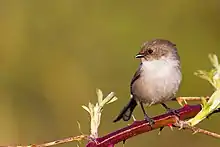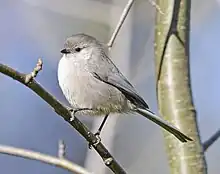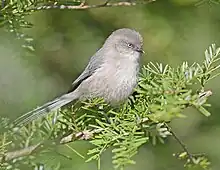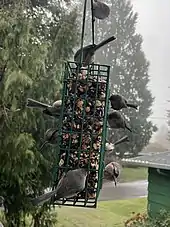American bushtit
The American Bushtit or simply Bushtit (Psaltriparus minimus) is a social songbird belonging to the genus Psaltriparus. It is one of the smallest passerines in North America and it is the only species in the family Aegithalidae that is found in United States; the other seven species are found in Eurasia.[2]
| American bushtit | |
|---|---|
 | |
| In Chilliwack, British Columbia, Canada | |
| Song of the P. minimus | |
| Scientific classification | |
| Domain: | Eukaryota |
| Kingdom: | Animalia |
| Phylum: | Chordata |
| Clade: | Dinosauria |
| Class: | Aves |
| Order: | Passeriformes |
| Family: | Aegithalidae |
| Genus: | Psaltriparus Bonaparte, 1850 |
| Species: | P. minimus |
| Binomial name | |
| Psaltriparus minimus (Townsend, 1837) | |
 | |
The American Bushtit's distinguishing characteristics are its petite size, its plump and large head, and its long tail.[3] It is classified under the family Aegithalidae. Its scattered range stretches from highland parts of Mexico and the Western United States to Vancouver, via the Great Basin, the lowlands and foothills of California, southern Mexico, and Guatemala. Bushtits usually inhabits mixed open woodlands, which contains oaks and a scrubby chaparral understory. It can also be found residing in gardens and parks. Their food source is small insects, primarily, spiders in mixed-species feeding flocks.[3]
The sharp-skinned hawk and other birds prey upon American Bushtits.[4] Bushtits live in flocks of 10 to 40 birds and family members sleep together in their large, hanging nest during breeding season. Once the offsprings develop wings that are developed enough to fly, they leave the nest and sleep on branches. The Bushtits display a unique behavior as adult males are typically the helpers that assists and raises the nestlings; hence it has intrigued many naturalists for its interesting breeding and mating patterns.[3]
Etymology
The name "bushtit" has its earliest known origins in the Latin word parus, which stands for titmouse. The tit in titmouse comes from the old Icelandic word titr meaning something small.[5]
Taxonomy
The scientific name Parus minimus was given to the bushtit after it was originally described in 1837 by American naturalist and ornithologist John Kirk Townsend, where he reported that the species inhabited the forests of the Columbia River.[2][6] It is now the only species placed in the genus Psaltriparus that was introduced in 1850 by the French naturalist Charles Lucien Bonaparte.[7][8] The genus name Psaltriparus combines the genus Psaltria that was introduced by Coenraad Temminck in 1836 for the pygmy bushtit with Parus that was introduced by Carl Linnaeus in 1758 for the tits.[9]
There are 10 subspecies recognized:[8]
- Psaltriparus minimus saturatus
Authority: Ridgway, 1903
Breeding Range: Southwest Canada and northwest USA
- Psaltriparus minimus minimus
Authority: Townsend, JK, 1837
Breeding Range: Coastal west USA
- Psaltriparus minimus melanurus
Authority: Grinnell & Swarth, 1926
Breeding Range: Southwest USA and north Baja California
- Psaltriparus minimus grindae
Authority: Ridgway, 1883
Breeding Range: South Baja California
- Psaltriparus minimus californicus
Authority: Ridgway, 1884
Breeding Range: South-central Oregon to South-central California
- Psaltriparus minimus plumbeus
Authority: Baird, SF, 1854
Breeding Range: West-central, south USA and Northcentral Mexico
- Psaltriparus minimus dimorphicus
Authority: Van Rossem & Hachisuka, 1938
Breeding Range: South-central USA and North-central Mexico
- Psaltriparus minimus iulus
Authority: Jouy, 1894
Breeding Range: West and Central Mexico
- Psaltriparus minimus personatus
Authority: Bonaparte, 1850
Breeding Range: South-Central Mexico
- Psaltriparus minimus melanotis
Authority: Hartlaub, 1844
Breeding Range: South Mexico and Guatemala
The subspecies P. m. melanotis was previously considered as a separate species due to their black ears.[10]
Description
With a length of 4.3 inches and a weight of 0.18-0.21 ounces, the American Bushtit is one of the tiniest passerines in North America. It is mostly gray-brown in color, with a large head, short neck, long tail, and small, stubby beak. Moreover, bushtits has different characteristics based on their sex and habitats. The male has dark brown to black eyes while the adult female has yellow eyes. Additionally, bushtits who stay near the coast tend to have a brown "cap" or "crowns," while those further inland have a brown "mask" on their faces.
The subspecies (P. m. melanotis) can be recognized from its dark ear patch, called the auricular. This feature does not occur in the northern part of the American bushtits' range and it was first seen near the Mexican border, mainly in Texas. None of the bushtits in that location with the black ear patch are adult females; the majority of them are juvenile males with one or two dark lines on their faces rather than a whole patch. Only in the northeastern highlands Mexican highlands does the black-eared variant become more prevalent farther south; all males have a full black ear patch, and even mature females have a black arc covering their eyes and typically a black line across them.[11]
Identifications
| Identification | Description | |
|---|---|---|
| Male (Pacific) | Tiny with a chubby appearance, large head, a lengthy tail, and a compact bill. Their feathers are predominantly plain shades of brown and gray, though the specific plumage colors differ based on their geographic location. |  Male Bushtit (Psaltriparus minimus) in Western Washington state. |
| Male (Interior) | Tiny with a long tail and short bill. They display a lighter shade of gray with gray crowns and tan cheeks, whereas those residing near the coast exhibit brown crowns. | |
| Male (Melanotis group) | Males in southwest Texas to Mexico have a black mask and display a shade of brown. The mask color tends to get darker as a bushtit moves further south. | |
| Female (Pacific) | Tiny like a ping-pong ball with long tail and pale eyes. |  Female Bushtit (Psaltriparus minimus) in Western Washington state. |
| Female (Interior) | They display grayer crowns and brown cheeks with pale eyes. | |
| Female (Melanotis group) | Females in southwest Texas to Mexico have a brown mask and display a shade of light brown. The mask color tends to become darker as a bushtit moves further south. |
Behavior

Bushtits usually inhabits mixed open woodlands, which contains oaks and a scrubby chaparral understory. It can also be found residing in gardens and parks. It lives under the highland parts of Mexico and the western United States to Vancouver, via the Great Basin, the lowlands and foothills of California, southern Mexico, and Guatemala.
Regarding its behavior, the American bushtit has an active and social demeanor. This species forms flocks of 10 to 40 individuals of various species, including chickadees and warblers, to forage for tiny insects and spiders in mixed-species environment. Group members frequently communicate with one another through what might be called brief spit calls.
Nesting
Both the males and females work together to construct the hanging nest, which can take up to a month to complete. The nest features a hole near the top that goes down into the nest bowl, and it hangs up to a foot below its anchor point. Using spider webs and plant material, the adults create an elastic sac. Occasionally, they sit inside the nest while it's still being built, which stretches it downward. They cover the outside with fragments of adjacent plants, including the tree the nest is made in, and add insulating materials like feathers, fur, and downy plant debris. All the adults connected to the nest, including the breeding pair and helpers, sleep there when it's in use.Typically, the couple uses the same nest for their second brood of the year. Regarding its placement, the male and female hang spiderwebs from mistletoe or other foliage to test-sites for their nests. Nest locations are typically found on tree trunks or branches, ranging in height from three to one hundred feet.[12]
Breeding
Female Bushtits lay plain white oval eggs in batches of 4-10, but both parents share the responsibility of incubation for 11–13 days. The egg is 0.5-0.6 inches in length and 0.4 inches in width. Once the chicks hatch, both the male and female Bushtits coorperate to feed and care for them for 14–18 days. They can raise 1-2 broods a year, and older siblings from the first brood may assist in feeding the next.[12][13]
During the breeding season, male and female Bushtits form pairs, actively participate in nest-building, and both engage in rearing the young. They are aided by other adult males who bring food to the nesting pair's nest.[14] Remarkably, during this time, the entire Bushtit family sleeps together in their large, hanging nest, unlike most breeding birds where only one adult typically sleeps on the nest at a time. After the young birds fledge, they move to sleeping on branches.[12]
However, Bushtits can be sensitive during the breeding process.[13] If there are disturbances in the early nesting stages, they may abandon their nesting attempt and potentially seek a different mate.[12]
Gallery
 Nest
Nest Nest
Nest_Nest.JPG.webp) Nest
Nest Pleasanton, California
Pleasanton, California
References
- BirdLife International (2018). "Psaltriparus minimus". IUCN Red List of Threatened Species. 2018: e.T22712028A132100477. doi:10.2305/IUCN.UK.2018-2.RLTS.T22712028A132100477.en. Retrieved 12 November 2021.
- Townsend, John Kirk (1837). "Description of twelve new species of birds, chiefly from the vicinity of the Columbia River". Journal of the Academy of Natural Sciences of Philadelphia. 7: 187-192 [190].
- "Bushtit Identification, All About Birds, Cornell Lab of Ornithology". www.allaboutbirds.org. Retrieved 2023-10-22.
- "Bushtit". www.oiseaux-birds.com. Retrieved 2023-10-22.
- "Tiny Birds Crowd the Bath | Outside My Window". 2020-01-31. Retrieved 2023-10-22.
- Paynter, Raymond A. Jr, ed. (1986). Check-List of Birds of the World. Vol. 12. Cambridge, Massachusetts: Museum of Comparative Zoology. p. 59.
- Bonaparte, Charles Lucien (1850). "Sur deux espèce nouvelles de Paridae". Comptes Rendus Hebdomadaires des Séances de l'Académie des Sciences (in French). 31: 478–479 [478].
- Gill, Frank; Donsker, David; Rasmussen, Pamela, eds. (July 2021). "Bushtits, leaf warblers, reed warblers". IOC World Bird List Version 11.2. International Ornithologists' Union. Retrieved 7 December 2021.
- Jobling, James A. (2010). The Helm Dictionary of Scientific Bird Names. London: Christopher Helm. p. 319. ISBN 978-1-4081-2501-4.
- Paynter, Raymond A. Jr, ed. (1986). Check-List of Birds of the World. Vol. 12. Cambridge, Massachusetts: Museum of Comparative Zoology. p. 61.
- academic.oup.com https://academic.oup.com/auk/article/84/4/503/5198090?login=false. Retrieved 2023-10-22.
{{cite web}}: Missing or empty|title=(help) - "Bushtit Life History, All About Birds, Cornell Lab of Ornithology". www.allaboutbirds.org. Retrieved 2023-10-22.
- "Bushtit Fact Sheet". The Spruce. Retrieved 2023-10-22.
- Bird, Alex (2019-01-24). "Bushtit". Bird Watching Academy. Retrieved 2023-10-22.
Further reading
- Skutch, Alexander F. (1960). "Black-eared bush-tit" (PDF). Life Histories of Central American Birds II. Pacific Coast Avifauna, Number 34. Berkeley, California: Cooper Ornithological Society. pp. 211–225.
- Sloane, Sarah A. (1996). "Incidence and origins of nest supernumeraries at Bushtit (Psaltriparus minimus) nests". Auk. 113: 757–770. doi:10.2307/4088855. JSTOR 4088855.
- Howell, Steve N. G.; Sophie Webb (1995). A Guide to the Birds of Mexico and Northern Central America. Oxford University Press. ISBN 0-19-854012-4.
- Sibley, David (2000). The Sibley Guide to Birds. Knopf. ISBN 0-679-45122-6.
- Sloane, S.A. (2001). Bushtit. In Birds of North America, A. Poole, P. Stettenheim, F. Gill, Eds. Philadelphia: American Ornithologists Union.
External links
- Bushtit species account – Cornell Lab of Ornithology
- "Bushtit media". Internet Bird Collection.
- Bushtit photo gallery at VIREO (Drexel University)
- Interactive range map of Psaltriparus minimus at IUCN Red List maps
